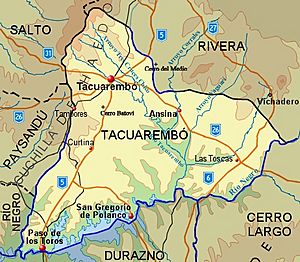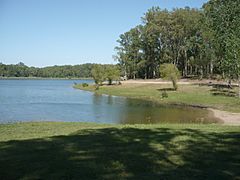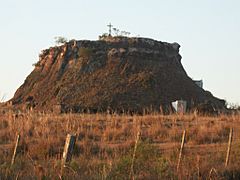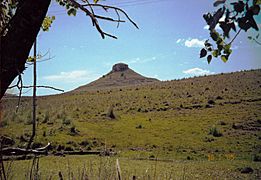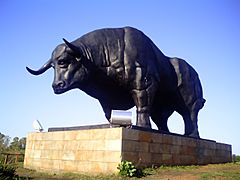Tacuarembó Department facts for kids
Quick facts for kids
Tacuarembó
|
||
|---|---|---|
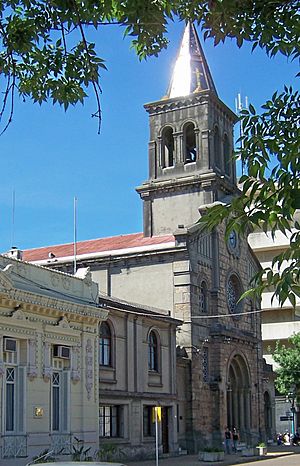
Tacuarembó cathedral.
|
||
|
||
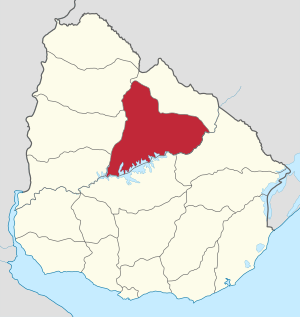
Location of Tacuarembó, in red, in Uruguay
|
||
| Country | ||
| Creation | 1837 | |
| Capital | Tacuarembó | |
| Area | ||
| • Total | 15,438 km2 (5,961 sq mi) | |
| Population
(2011)
|
||
| • Total | 90,053 | |
| • Density | 5.83320/km2 (15.1079/sq mi) | |
| Demonym(s) | Tacuaremboense | |
| Time zone | UTC-03 (UYT) | |
| ISO 3166 code | UY-TA | |
| Website | Official website: http://www.imtacuarembo.gub.uy | |
The Tacuarembó department (Spanish: Departamento de Tacuarembó) is a department of Uruguay. The capital is the city of Tacuarembó.
Its ISO 3166-2 code is UY-TA.
Name
The department and its capital city are named after Tacuarembó river, the main tributary of the Río Negro river.
History
The first division in departments of Uruguay was in 1816. At that time, the Paysandú Department included all the territory north of the Río Negro, including the actual departments of Artigas, Rivera, Tacuarembó, Salto, Paysandú and Río Negro. On 16 June 1837 a new division of Uruguay was made and this territory was divided in three parts; one of these parts was the Tacuarembó Department that included also the actual department of Rivera, until it was split from it in 1884.
Geography
The Tacuarembó department is in the north central part of the country. It has an area of 15,438 km2 (5,961 sq mi), the largest in the country. It is has a population of 90,053 inhabitants (2011 census) for a population density of 5.8.
To the west of the department there is a chains of low and rounded hills in the department, the Cuchilla de Haedo.
Limits
It borders Rivera Department to its north and northeast, the departments of Salto, Paysandú and Río Negro to its west and Durazno and Cerro Largo to the south separated by the Río Negro.
 |
Salto | Rivera | Rivera |  |
| Paysandú | Cerro Largo | |||
| Río Negro | Durazno | Cerro Largo |
Rivers
The Río Negro river forms the southern border of the department but the most important river that is completely within the department is the Tacuarembó river, the main tributary of Río Negro.
Climate
The Köppen climate classification type for the climate at Paso de los Toros, in the southwest of the department, is a "Humid subtropical climate" and of the subtype Cfa.
The average amount of precipitation for the year in Paso de los Toros is 1,244.6 mm (49.0 in). The month with the most precipitation on average is January with 132.1 mm (5.2 in) of precipitation. The month with the least precipitation on average is December with an average of 86.4 mm (3.4 in).
The average temperature for the year in Paso de los Toros is 17.7 °C (63.9 °F). The warmest month, on average, is January with an average temperature of 24.6 °C (76.3 °F). The coolest month on average is July, with an average temperature of 11.4 °C (52.5 °F).
Demographics
The inhabitants of the Tacuarembó department (and of the city of Rivera) are known, in Spanish, as Tacuaremboenses.
Evolution of the population in Tacuarembó

- Rural population
According to the 2011 census, the Tacuarembó department has a rural population of 9,660.
- Main towns
| City / Town | Population (2011) |
|---|---|
| Tacuarembó | 54,755 |
| Paso de los Toros | 12,985 |
| San Gregorio de Polanco | 3,415 |
| Ansina | 2,712 |
| Las Toscas | 1,142 |
| Curtina | 1,037 |
Gallery
-
Iporá lake.
Related pages
See also
 In Spanish: Departamento de Tacuarembó para niños
In Spanish: Departamento de Tacuarembó para niños



